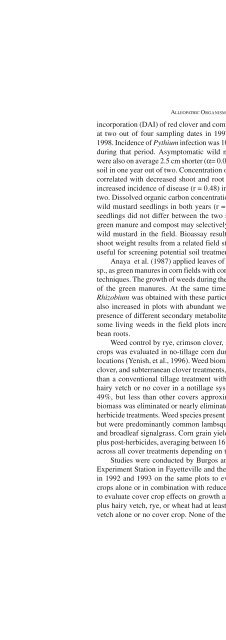Allelochemicals Biologica... - Name
Allelochemicals Biologica... - Name
Allelochemicals Biologica... - Name
You also want an ePaper? Increase the reach of your titles
YUMPU automatically turns print PDFs into web optimized ePapers that Google loves.
ALLEOPATHIC ORGANISMS AND<br />
MOLECULES<br />
incorporation (DAI) of red clover and compost, with significant differences (α= 0.05)<br />
at two out of four sampling dates in 1997, and four out of four sampling dates in<br />
1998. Incidence of Pythium infection was 10-70% greater in the amended soil treatment<br />
during that period. Asymptomatic wild mustard seedlings grown in amended soil<br />
were also on average 2.5 cm shorter (α= 0.05) at 5 DAI than those grown in unamended<br />
soil in one year out of two. Concentration of phenolic compounds in soil solution was<br />
correlated with decreased shoot and root growth (r = 0.50, 0.28, respectively) and<br />
increased incidence of disease (r = 0.48) in wild mustard seedlings in one year out of<br />
two. Dissolved organic carbon concentration was correlated with increased disease in<br />
wild mustard seedlings in both years (r = 0.51, 0.33, respectively). Growth of corn<br />
seedlings did not differ between the two soil treatments, suggesting that red clover<br />
green manure and compost may selectively reduce density and competitive ability of<br />
wild mustard in the field. Bioassay results corresponded well with emergence and<br />
shoot weight results from a related field study, indicating that this technique may be<br />
useful for screening potential soil treatments prior to field studies.<br />
Anaya et al. (1987) applied leaves of Alnus firmifolia, Berula erecta and Juncus<br />
sp., as green manures in corn fields with corn, bean, and squash grown using traditional<br />
techniques. The growth of weeds during the crop period was decreased by the presence<br />
of the green manures. At the same time, stimulation of bean root nodulation by<br />
Rhizobium was obtained with these particular green manure species, nodulation was<br />
also increased in plots with abundant weed growth. These results suggest that the<br />
presence of different secondary metabolites liberated by these green manures and by<br />
some living weeds in the field plots increase the ability of Rhizobium sp. to infect<br />
bean roots.<br />
Weed control by rye, crimson clover, subterranean clover, and hairy vetch cover<br />
crops was evaluated in no-tillage corn during 1992 and 1993 at two North Carolina<br />
locations (Yenish, et al., 1996). Weed biomass reduction was similar with rye, crimson<br />
clover, and subterranean clover treatments, ranging between 19 and 95% less biomass<br />
than a conventional tillage treatment without cover. Weed biomass reduction using<br />
hairy vetch or no cover in a notillage system was similar averaging between 0 and<br />
49%, but less than other covers approximately 45 and 90 d after planting. Weed<br />
biomass was eliminated or nearly eliminated in all cover systems with pre- plus postherbicide<br />
treatments. Weed species present varied greatly between years and locations,<br />
but were predominantly common lambsquarters, smooth pigweed, redroot pigweed,<br />
and broadleaf signalgrass. Corn grain yield was greatest using pre-herbicides or preplus<br />
post-herbicides, averaging between 16 to 100% greater than the nontreated control<br />
across all cover treatments depending on the year and location.<br />
Studies were conducted by Burgos and Talbert (1996) at the Main Agricultural<br />
Experiment Station in Fayetteville and the Vegetable Substation in Kibler, Arkansas,<br />
in 1992 and 1993 on the same plots to evaluate weed suppression by winter cover<br />
crops alone or in combination with reduced herbicide rates in no-till sweet corn and<br />
to evaluate cover crop effects on growth and yield of sweet corn. Plots seeded to rye<br />
plus hairy vetch, rye, or wheat had at least 50% fewer early season weeds than hairy<br />
vetch alone or no cover crop. None of the cover crops reduced population of yellow<br />
51


